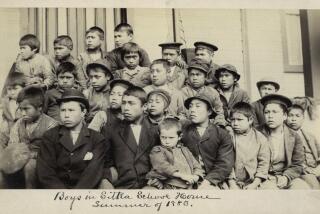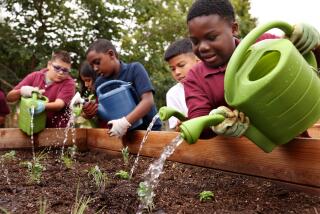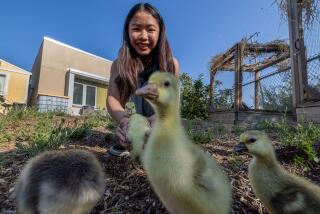School Offers Community-Friendly Education
TESUQUE PUEBLO, N.M. â A bunch of high school students hunkered down, intently examining a pile of goop they had just scooped from a small stream.
âOoh, thatâs gross,â one girl groaned.
Suddenly there were shrieks of surprise, as a 3-inch brown trout was retrieved from the wet debris.
With admiring âoohsâ and âahs,â the fish was sent gently on its way and the students went back to work, documenting the wiggly stone flies, caddis flies and other larval-stage insects that are indicators of stream health.
Learning environmental science along the Tesuque River is part of Santa Fe Indian Schoolâs new emphasis on community-based education. The idea is to make the schoolâs curriculum relevant to the needs of Native American communities.
That could not only help tribes, but also keep their members closer to home, says Joseph Abeyta, superintendent of the tribally operated boarding school.
âA lot of our very bright people were taking jobs and opportunities away from home, and that was a significant drain on our resources,â he says.
Preparing tribal members for high-tech careers could allow them to live in their communities while working for private firms, government agencies, national laboratories--or their own tribes.
âIf these students learn the technology, they can then go back to their tribes and fill a role that ordinarily the tribe would have to hire an outsider for,â says Glenda Moffitt, the schoolâs director of planning and evaluation.
Santa Fe Indian School, run by a board appointed by New Mexicoâs 19 pueblo governors, has students in grades 7 through 12. While many of the 500 students come from the pueblos, they also come from the Navajo, Mescalero, Jicarilla, Hopi and other tribes across the country. Most live at the school on a 100-acre campus in the heart of Santa Fe.
On the Tesuque project, students are creating a repository of information about the river--its flow, aquatic life and water quality--that will help both Tesuque Pueblo and state fisheries managers.
Itâs part of a statewide program sponsored by the state Department of Game and Fish that is aimed at getting a handle on the health of streams.
But the studentsâ extensive data collection also will contribute to an environmental study Tesuque Pueblo is conducting.
And it could help the tribe assess its water-quality standards. The four-mile stretch of the river that runs through the pueblo north of Santa Fe is important not only for irrigation and recreation--it feeds a fishing pond--but for ceremonial purposes.
âItâs fun,â says Kimberly Sisneros, 16, a sophomore from Santa Clara Pueblo. âItâs interesting seeing whatâs in the water. . . . Youâre doing it, instead of imagining what it would be like.â
While Sisneros and her classmates did a low-tech search of the river water for insects one recent morning, Maya Torralba, 17, a Kiowa-Comanche from Anadarko, Okla., circled the area with a small, yellow, hand-held device.
The sophisticated instrument, which picks up satellite data, was being used to help map the area. Torralba, a junior, sat down near the river and checked her progress on a portable computer.
In this experimental year, about 100 students have had some type of community-based instruction, Moffitt says.
A senior environmental science class, in conjunction with Los Alamos National Laboratory, studied the generation, use and disposal of nuclear waste. The students visited a restoration project at Laguna Pueblo, site of a former uranium mine.
Sophomores in a computer science class have already helped set up computers, trained other students and established a computer network across the campus, Moffitt says.
âThe computers are awesome. Itâs amazing to see some of the data that comes up,â says Matt Perez, 17, a junior who is Picuris and Cochiti. âEvery single day you learn something new.â
Next year, SFIS hopes to establish a âschool within a school,â in which for some students the entire curriculum--including science, math and language arts--would be community-based, Moffitt says.
SFIS has some powerful partners in its community-based education efforts: Intel, the worldâs largest computer-chip maker, and the U.S. Department of Energy.
Intel has donated a $285,000, top-of-the-line computer laboratory to the school and an additional $215,000 in equipment and cash grants. It expects to pump $100,000 more into the school by the end of 1997.
The Department of Energy has provided a $150,000 grant.
More to Read
Sign up for Essential California
The most important California stories and recommendations in your inbox every morning.
You may occasionally receive promotional content from the Los Angeles Times.










